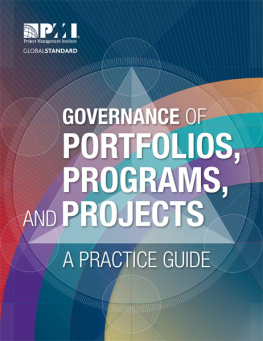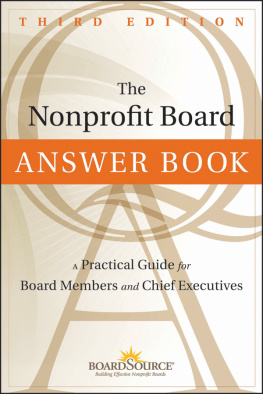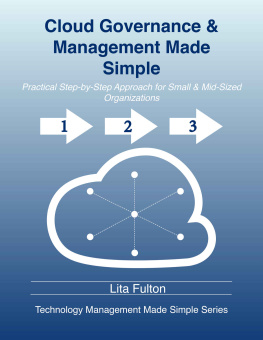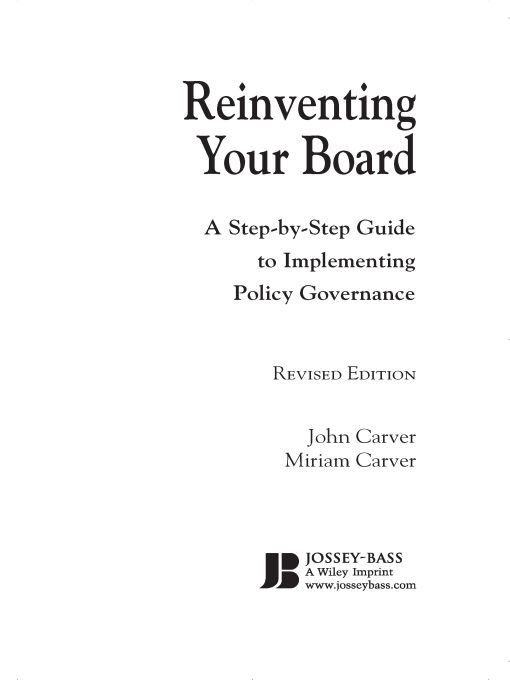Table of Contents
Table of Figures
Table of Exhibits
Other Carver Resources:
Boards That Make a Difference: A New Design for Leadership in Nonprofit and Public Organizations, Third Edition, by John Carver
John Carver on Board Leadership: Selected Writings from the Creator of the Worlds Most Provocative and Systematic Governance Model, by John Carver
Board Leadership: Policy Governance in Action, co-executive editors John Carver and Miriam Carver
The Board Members Playbook: Using Policy Governance to Solve Problems, Make Decisions, and Build a Stronger Board, by Miriam Carver and Bill Charney
Corporate Boards That Create Value: Governing Company Performance from the Boardroom, by John Carver and Caroline Oliver
The CarverGuide Series on Effective Board Governance (12 guides)
John Carver on Board Governance (video)
Empowering Boards for Leadership: Redefining Excellence in Governance (audio)
The Policy Governance Fieldbook: Practical Lessons, Tips, and Tools from the Experiences of Real-World Boards, editor Caroline Oliver
Preface to the Revised Edition
We are happy to present this revised edition of our 1997 text, which has been released at about the same time as the third edition of John Carvers Boards That Make a Difference. In the interim since our first edition, we have authored or coauthored three other books. An anthology of 112 of John Carvers published articles was published as John Carver on Board Leadership in 2002, assembling under one cover articles published in several countries over twenty-two years. Also in 2002, John Carver and coauthor Caroline Oliver brought book-length Policy Governance to the equity corporate world in Corporate Boards That Create Value. With coauthor Bill Charney in 2004, Miriam Carver wrote The Board Members Playbook, a workbook for boards to enhance their Policy Governance skills by structured and regular practice.
As in the first edition, we assume the reader of this text is thoroughly familiar with the Policy Governance model, possibly through reading Boards That Make a Difference or attending seminars by qualified Policy Governance consultants. (We recognize as qualified only persons who have graduated from the intensive, limited-entry Policy Governance Academy.) However, as before we do provide a brief model overview in Chapter Two, The Theoretical Foundation. Theory is extremely important in Policy Governance, though it is a largely overlooked idea in governance as generally practiced. We are aware some readers may be a bit suspicious of so rarified-sounding a word, but the need for a conceptually coherent foundation is as important for governance as it is for aviation, medicine, and physics.
The task that confronts implementation, of course, is accurately translating theory into practice, turning carefully crafted ideas into carefully crafted actions. Policy Governance as a theory of governance has evolved over the years since its inception in the mid-1970s. Although the model itself has not changed a great dealprobably not at all in its most important featuresits practice has progressed substantially. We have found better ways to phrase the policies. We have developed far more rigorous ways to monitor performance. We have, in short, continued over the years to advance in terms of best practices within the model.
We need to point out that traditional boards cannot achieve the rigor of Policy Governance by following the best practices route. Best practices, as the popular term is currently used, merely improve action within the extant paradigm. That is undoubtedly a good idea, but is forever trapped in the old concepts. The vaunted changes in the past few years in corporate governance are good examples of such incremental change. The change promised by Policy Governance is not incremental but transformational. It is more like the change from football to tennis, one that cannot be made by any degree of improvement in ones football. Yet once the change is made, then the search for best practices begins all over again, just as it would after a change to tennis.
Reinventing Your Board is one of our contributions to best practices in the implementation of the Policy Governance model. Clearly, the practices in these pages will not be helpfuland may even be nonsensicalfor a board committed to the old ways. This book is meant for boards that have boldly decided for governing excellence but have no access to qualified consulting assistance in moving forward. To help them, in this edition we have added new policy samples and a new chapter on monitoring performance. Although the basic organization of the book is unchanged, we have edited the text in response to the many helpful comments we have received from our clients, our Policy Governance Academy trainees, our editors at Jossey-Bass, and the reviewers Jossey-Bass helpfully supplied.
Atlanta, Georgia
December 2005
John Carver
Miriam Carver
Preface
Since you have picked up this book, chances are that you and your board want to use Policy Governance to bring your organization to new levels of achievement.
Perhaps you were initially frustrated because the very concerns that led you to be on the board in the first place were the ones seldom discussed. (We have met countless school board members who were confused because they rarely talked about children, and members of hospital boards who rarely discussed the health of the community.) Perhaps you have already made gestures toward implementing Policy Governance but have simply needed more guidance on how and where to begin.
Congratulations! Contemplating a radical change in the way your board works is a brave step. This book is your guide to the application of a robust new governance model to your board.
We will assume you realize that Policy Governance offers a powerful approach to governance, one that is conceptually whole and oriented toward obtaining results for people rather than promoting organizational busy-ness. But because Policy Governance flies in the face of so much received wisdom and tradition, old habits may be hard to overcome. Wouldnt it be nice to start at the beginning with a brand new board, doing it all right from the start? But yours is an ongoing organization, perhaps with a rich tradition; your organization is also weighed down with structures already in place, ways of doing business that are hard to change, and personalities wed to old ways. You want to be a board that makes a difference, but you fear that implementing Policy Governance in a going business may be as complex as changing an airplane from propeller-driven to jet in mid-air.
We believe that board members dont have time to waste. We believe that they want to make a difference. We believe that the board has a real, not a ceremonial, job to do. And we are sure that the system of governance used traditionally in our nonprofit and public organizations is inadequate to provide boards with the skills and mechanisms they require to be effective leaders.
In 1990, the senior author, John Carver, wrote Boards That Make a Difference (Carver, 1990), a book that exposes the shortcomings of traditional governance and that substantially redefines the job of the board. The Policy Governance model, as he called his new design, has become widely known, and many boards have begun to implement its principles. Since implementing Policy Governance involves developing newly defined types of policies, getting board commitment to act according to those policies, and delegating to a CEO in a new and exciting way, the boardroom and our concept of the boards job are extensively altered. With a change this big, it is no wonder that most boards need to secure help in moving forward.








